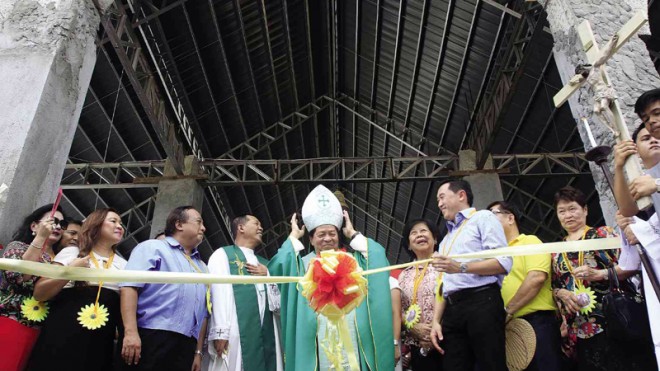No place like a tent in Bohol

NEW HOPE An alternative church is opened by Bishop Leonardo Medroso in Loboc town, Bohol province, where three churches were flattened during the Oct. 15, 2013, quake. MARIANNE BERMUDEZ
(First of three parts)
SAGBAYAN, Bohol—Earthquake survivor Remedios Alpuerto already has a new home in Barangay (village) Ubojan here, but for her and her family nothing beats living in a tent when another tremor strikes again.
In fact, the tent where the Alpuertos found haven when the disastrous 7.2-magnitude quake struck on Oct. 15 last year still stands outside their new home—just in case another tremor rumbles through Bohol again.
The tent was the Alpuertos’ home for nine months after the 2013 tremor leveled their old house and other structures—including churches—and killed more than 200 people in the province.
For Remedios, her tent is the safest place where she, her husband and four children can run to whenever the earth shakes again.
Article continues after this advertisement“We don’t consider our new house to be safe despite their assurance that it can withstand strong earthquakes. We cannot afford to be complacent,” she told the Inquirer.
Article continues after this advertisement“It is still advantageous to have a tent. The tent is safe even if there are strong winds.”
Who can blame them?
Remedios is not alone in her anxieties.
Other tents can be seen in front of some of the houses built by the International Organization for Migration—residents are scared another strong quake would happen again.
But who can blame them? Last year’s temblor—the strongest to hit the province in years—brought so much devastation to this island-province.
43 towns affected
According to the Bohol Provincial Disaster Risk Reduction and Management Council (PDRRMC), the quake—which sprang from a new fault line in Inabanga town—affected 43 out of 47 Bohol towns and the capital Tagbilaran City.
Of the 43 towns, 17 were badly hit.
These were the towns of Antequera, Balilihan, Buenavista, Calape, Carmen, Catigbian, Clarin, Corella, Cortes, Danao, Inabanga, Loon, Maribojoc, Sagbayan, San Isidro, Sevilla and Tubigon, according to the PDRRMC.
The PDRRMC said 211 people were killed while 877 were hurt in the violent jolt. Eight others remain missing. It isn’t clear if they will be accounted for again.
Some churches flattened
A total of 95,884 families, or 465,146 people, were displaced as the quake destroyed 8,083 houses and damaged 42,771 others in 43 towns and one city.
The quake severely affected the province’s tourism industry—Bohol’s bread and butter. Tourist arrivals hit a record low as tourism spots on the island were either damaged or destroyed.
Three churches were flattened in Loon, Maribojoc and Clarin.
At least 22 other churches suffered damage in varying degrees—10 of them were later declared as heritage sites.
The viewing deck of the famed Chocolate Hills was destroyed. Restaurants and boats used in the Loboc River Cruise were also damaged.
Rumbling trucks shake nerves
A year after Alpuerto’s old house disappeared, aftershocks still shake the nerves of the Boholanos.
Alpuerto, her husband and four children—ages 14, 13, 10 and 9—are now living in a 5-meter-by-6-meter house made of “amakan” (bamboo woven mat), lumber and GI sheets.
But their so-called “permanent shelter” has failed to make them feel safe, Alpuerto said.
She said her family would get scared whenever the ground vibrated at the passing of a six-wheeler truck in front of their house.
Safety in tents
At least, the tent near the house gives Alpuerto’s family a feeling that they have somewhere to run to—where they cannot be pinned down by heavy objects, like what happened to villagemates who died in the quake.
Felito Pon, head of the Municipal Disaster Risk Reduction and Management Council, said tents could still be seen in four out of 24 barangays in Sagbayan.
These are the barangays Canmaya Diot, Poblacion, Ubojan and Sta. Catalina.
While the council doesn’t have the number of families that continue to hold on to their tents, Pon said villagers were still scared of the aftershocks.
From Oct. 15, 2013 to May 31, 2014, at least 6,000 aftershocks were recorded, according to the Philippine Institute of Volcanology and Seismology (Phivolcs).
Phivolcs assurance
Robinson Giorgio, chief of the Phivolcs office in Central Visayas, said these were “minor earthquakes” ranging from 2.3 to 3 in magnitude.
He said the institute had stopped recording aftershocks in Bohol since May because their magnitude had lessened, an indication the ground was stabilizing.
Phivolcs has said that it will take years before another earthquake of the 2013 magnitude hits Bohol again.
People still scared
But many Boholanos are not convinced.
Victoria Betarmus would still carry her 7-month-old granddaughter Kristel Mae running outside her temporary house in Barangay Maria Rosario in Inabanga town whenever the earth shook.
“We are still scared. I would tremble every time an aftershock occurred,” she told the Inquirer.
Even school classes have been disrupted by aftershocks.
Ma. Teresita Lapiz, a Grade 5 public school teacher in Calatrava town, said pupils would stay still and quiet during strong aftershocks, as if waiting for something to collapse.
She said the teachers had to assure the children nothing bad would happen to ease their fear and help them return to their lessons.
“We have no choice but to adapt to the situation. The pupils need to go to school and we have to conduct classes because we cannot [keep them from their studies] for a long time,” Lapiz said.
Boholanos are trying to cope with the situation despite what some see as lack of support from the national government.
(Next: Red tape delays release of funds)
RELATED STORIES
Bohol quake survivors feel ‘safer’ in bunkhouses
Bohol wants to build houses that can withstand earthquakes, floods